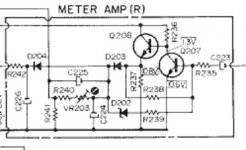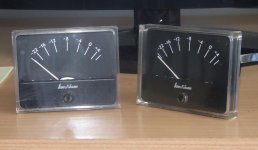I have a silly question. How fast can you reliably drive a needle indicator? How fast can you get it to move into position and then stop exactly where it needs to be? Assuming you drive it with a network to compensate for needle mass?
I don't know this one. An Electrovoice ?We had an EV-15 that I really liked
Chris
How many volts do you have?I have a silly question. How fast can you reliably drive a needle indicator? How fast can you get it to move into position and then stop exactly where it needs to be? Assuming you drive it with a network to compensate for needle mass?
I don't know this one. An Electrovoice ?
RE15. Dynamic cardioid with a plastic vent rib in the handle. Also at one point sold as an Altec model D645.
Let's say as many as it can handle?
If it's one of those meters with just a copper strap next to a magnetized drum, then I suppose the leakage inductance of the wiring and the weak coupling to the drum would be the major barriers.
If it's one of those meters with just a copper strap next to a magnetized drum, then I suppose the leakage inductance of the wiring and the weak coupling to the drum would be the major barriers.
To answer partially your question, just have a look of how Nakamichi (550) did-it (It was a nice peak meter for K7 tapes):I have a silly question. How fast can you reliably drive a needle indicator? How fast can you get it to move into position and then stop exactly where it needs to be? Assuming you drive it with a network to compensate for needle mass?
Attachments
Last edited:
Ah, ok, this one, I know, despite Electrovoice mikes were never very widespread, in France where Neuman, Sennheiser and AGK leaded the market. (And Shoeps a little less). And later, Audio-Technica.RE15. Dynamic cardioid with a plastic vent rib in the handle.
On stage, sure, It was Shure ;-)
RE15. Dynamic cardioid with a plastic vent rib in the handle. Also at one point sold as an Altec model D645.
Yes, thanks for fixing my brain fart. These days the old mics need their foams replaced, but that was probably true when I last used that RE15.
Much thanks as always,
Chris
I don't know this one. An Electrovoice ?
Yep. Too bad you haven't heard it, Christophe, it's one hell of good speaker.
He he as we were talking about mikes, I was confused. But, as I haven't heard this speaker as well, I stay confused ;-)Yep. Too bad you haven't heard it, Christophe, it's one hell of good speaker.
Yep. Too bad you haven't heard it, Christophe, it's one hell of good speaker.
That would be the long discontinued EV Sentry 100 2 way monitor loudspeaker. Very popular for radio and TV broadcasters in it's day.
Very fast if designed right. There are pen recorders with MS response times.I have a silly question. How fast can you reliably drive a needle indicator? How fast can you get it to move into position and then stop exactly where it needs to be? Assuming you drive it with a network to compensate for needle mass?
Real program meters, VU or the simliar ppm have very precise dynamics. They predate brick wall recording tech (digital) so they don't catch true peaks. For that the computers beat everything.
Sent from my SGH-M919 using Tapatalk
Very fast if designed right. There are pen recorders with MS response times.
Real program meters, VU or the simliar ppm have very precise dynamics. They predate brick wall recording tech (digital) so they don't catch true peaks. For that the computers beat everything.
Sent from my SGH-M919 using Tapatalk
keantoken read here on rate adaptive plotting, in general all the stuff in this article is pure genius engineering such a relief from the snake oil.
http://isis.poly.edu/~kurt/barrie_gilbert.pdf
Thanks for that Scott. The first reference book is an excellent read and led me to the Sloan technology series. Fun stuff to read about real world genius!
keantoken read here on rate adaptive plotting, in general all the stuff in this article is pure genius engineering such a relief from the snake oil.
http://isis.poly.edu/~kurt/barrie_gilbert.pdf
That is about magnetrons? Now I see, the indicator is burned on a moving sheet of paper by a microwave beam. Instant response time!
I think it is the material about the way that sampling scopes work---but I only gave it a cursory scan. Barrie does write well, and has had a fascinating career and personal history.That is about magnetrons? Now I see, the indicator is burned on a moving sheet of paper by a microwave beam. Instant response time!
In their day, open reel decks of better quality used to offer peak LEDs along with VU meters. They usually worked independently gfrom the VU mesters. My old Philips N4520 deck had two LEDs per side, +3 and +6 dB.
The fastest mechanical meters I ever saw were those MCI built into their studio machines. At times, it was faster than the eye could register them, but I hate to think how much that added to the price.
The fluo meters on my Sony TC-K808 ES are also lightning fast, it's fascinating just watching them work, but Sony had the good sense to include a peak hold function.
The fastest mechanical meters I ever saw were those MCI built into their studio machines. At times, it was faster than the eye could register them, but I hate to think how much that added to the price.
The fluo meters on my Sony TC-K808 ES are also lightning fast, it's fascinating just watching them work, but Sony had the good sense to include a peak hold function.
A couple of models of Aiwa cass decks had meters with twin needles....one indicating VU and the other indicating peak with slow decay.
Dan.
Dan.
- Status
- Not open for further replies.
- Home
- Member Areas
- The Lounge
- John Curl's Blowtorch preamplifier part II

